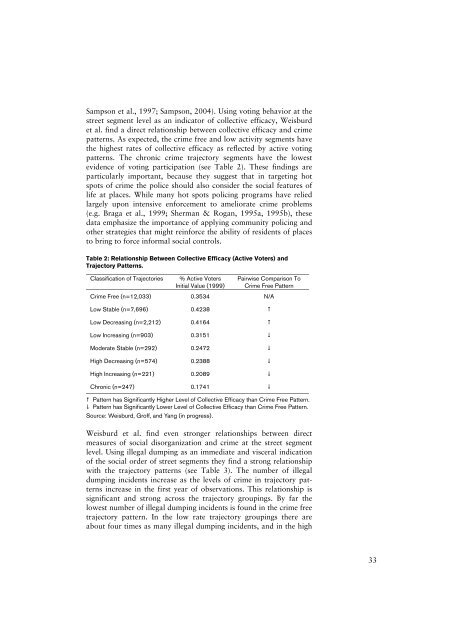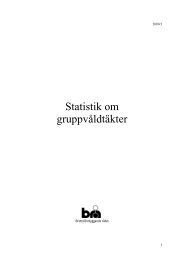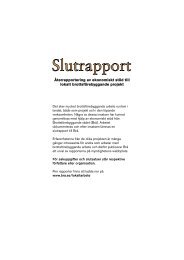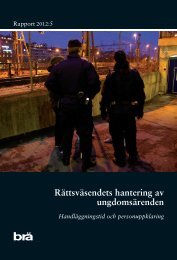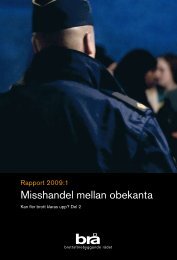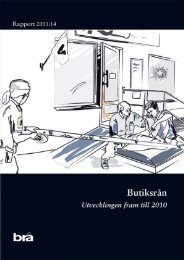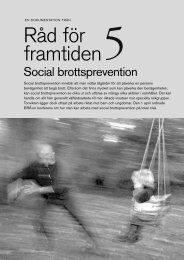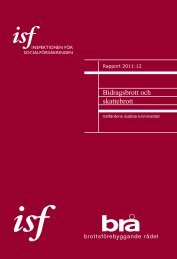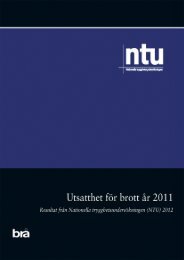The Importance of Place in Policing - Empirical Evidence and Policy ...
The Importance of Place in Policing - Empirical Evidence and Policy ...
The Importance of Place in Policing - Empirical Evidence and Policy ...
Create successful ePaper yourself
Turn your PDF publications into a flip-book with our unique Google optimized e-Paper software.
Sampson et al., 1997; Sampson, 2004). Us<strong>in</strong>g vot<strong>in</strong>g behavior at thestreet segment level as an <strong>in</strong>dicator <strong>of</strong> collective efficacy, Weisburdet al. f<strong>in</strong>d a direct relationship between collective efficacy <strong>and</strong> crimepatterns. As expected, the crime free <strong>and</strong> low activity segments havethe highest rates <strong>of</strong> collective efficacy as reflected by active vot<strong>in</strong>gpatterns. <strong>The</strong> chronic crime trajectory segments have the lowestevidence <strong>of</strong> vot<strong>in</strong>g participation (see Table 2). <strong>The</strong>se f<strong>in</strong>d<strong>in</strong>gs areparticularly important, because they suggest that <strong>in</strong> target<strong>in</strong>g hotspots <strong>of</strong> crime the police should also consider the social features <strong>of</strong>life at places. While many hot spots polic<strong>in</strong>g programs have reliedlargely upon <strong>in</strong>tensive enforcement to ameliorate crime problems(e.g. Braga et al., 1999; Sherman & Rogan, 1995a, 1995b), thesedata emphasize the importance <strong>of</strong> apply<strong>in</strong>g community polic<strong>in</strong>g <strong>and</strong>other strategies that might re<strong>in</strong>force the ability <strong>of</strong> residents <strong>of</strong> placesto br<strong>in</strong>g to force <strong>in</strong>formal social controls.Table 2: Relationship Between Collective Efficacy (Active Voters) <strong>and</strong>Trajectory Patterns.Classification <strong>of</strong> Trajectories% Active VotersInitial Value (1999)Pairwise Comparison ToCrime Free PatternCrime Free (n=12,033) 0.3534 N/ALow Stable (n=7,696) 0.4238 Low Decreas<strong>in</strong>g (n=2,212) 0.4164 Low Increas<strong>in</strong>g (n=903) 0.3151 Moderate Stable (n=292) 0.2472 High Decreas<strong>in</strong>g (n=574) 0.2388 High Increas<strong>in</strong>g (n=221) 0.2089 Chronic (n=247) 0.1741 Pattern has Significantly Higher Level <strong>of</strong> Collective Efficacy than Crime Free Pattern. Pattern has Significantly Lower Level <strong>of</strong> Collective Efficacy than Crime Free Pattern.Source: Weisburd, Gr<strong>of</strong>f, <strong>and</strong> Yang (<strong>in</strong> progress).Weisburd et al. f<strong>in</strong>d even stronger relationships between directmeasures <strong>of</strong> social disorganization <strong>and</strong> crime at the street segmentlevel. Us<strong>in</strong>g illegal dump<strong>in</strong>g as an immediate <strong>and</strong> visceral <strong>in</strong>dication<strong>of</strong> the social order <strong>of</strong> street segments they f<strong>in</strong>d a strong relationshipwith the trajectory patterns (see Table 3). <strong>The</strong> number <strong>of</strong> illegaldump<strong>in</strong>g <strong>in</strong>cidents <strong>in</strong>crease as the levels <strong>of</strong> crime <strong>in</strong> trajectory patterns<strong>in</strong>crease <strong>in</strong> the first year <strong>of</strong> observations. This relationship issignificant <strong>and</strong> strong across the trajectory group<strong>in</strong>gs. By far thelowest number <strong>of</strong> illegal dump<strong>in</strong>g <strong>in</strong>cidents is found <strong>in</strong> the crime freetrajectory pattern. In the low rate trajectory group<strong>in</strong>gs there areabout four times as many illegal dump<strong>in</strong>g <strong>in</strong>cidents, <strong>and</strong> <strong>in</strong> the high33


